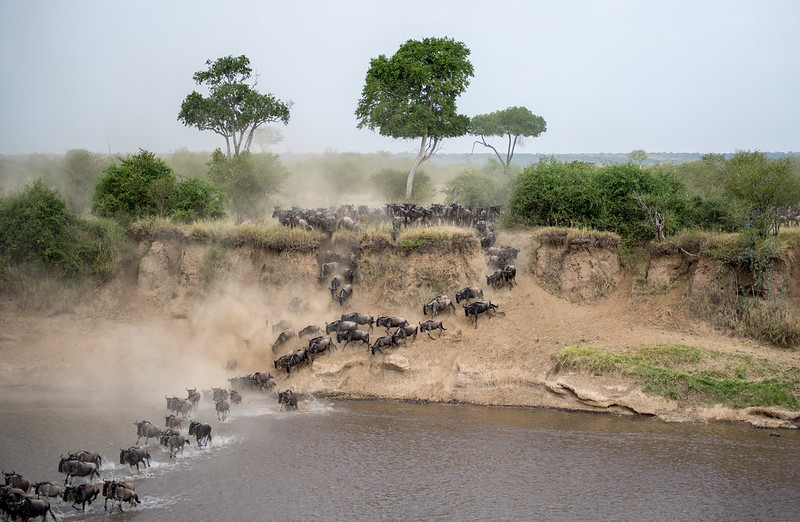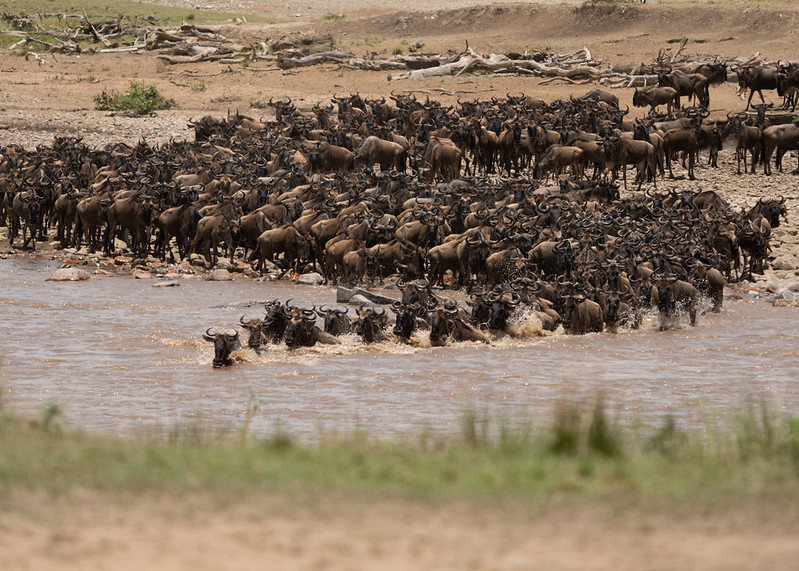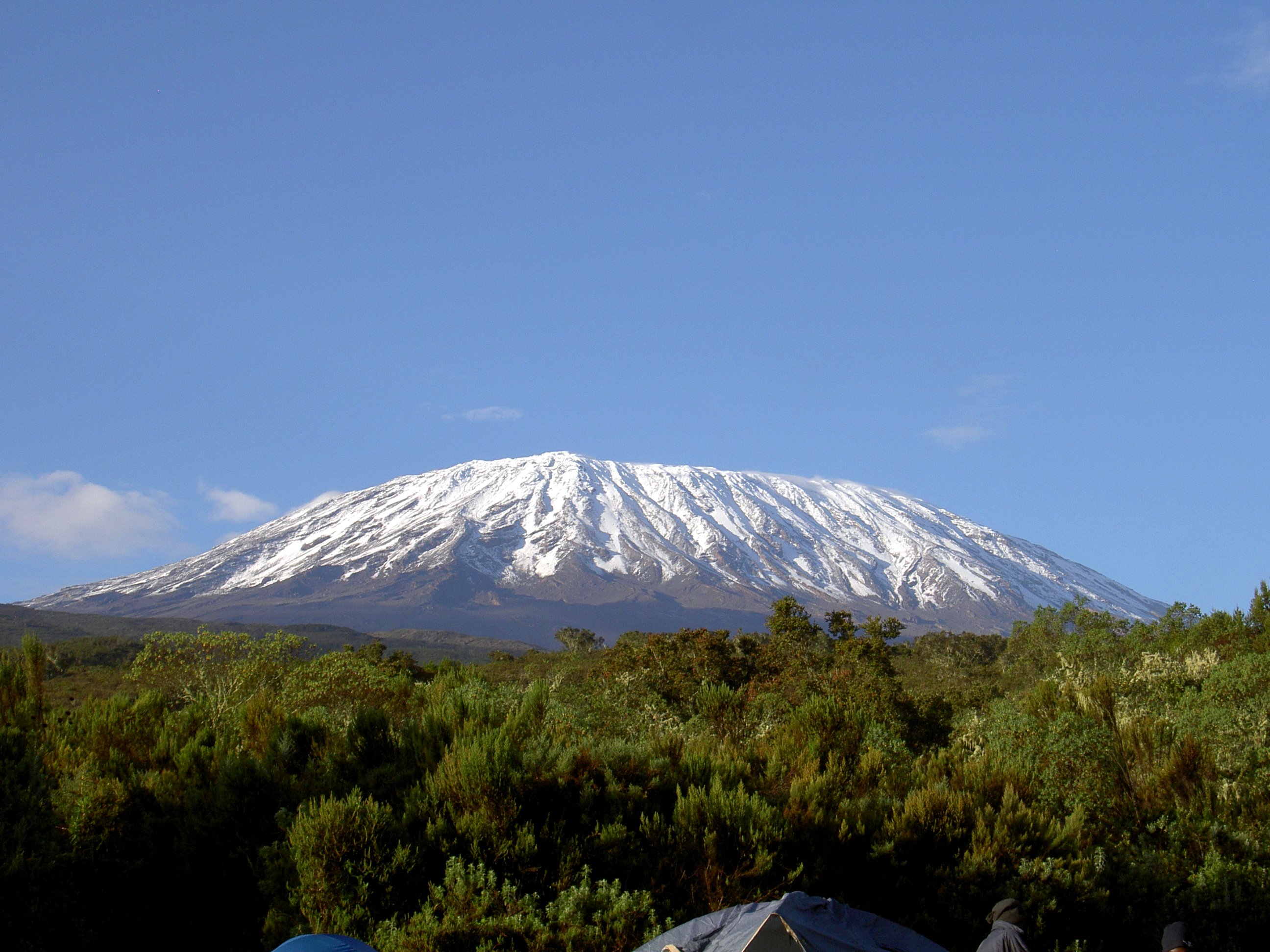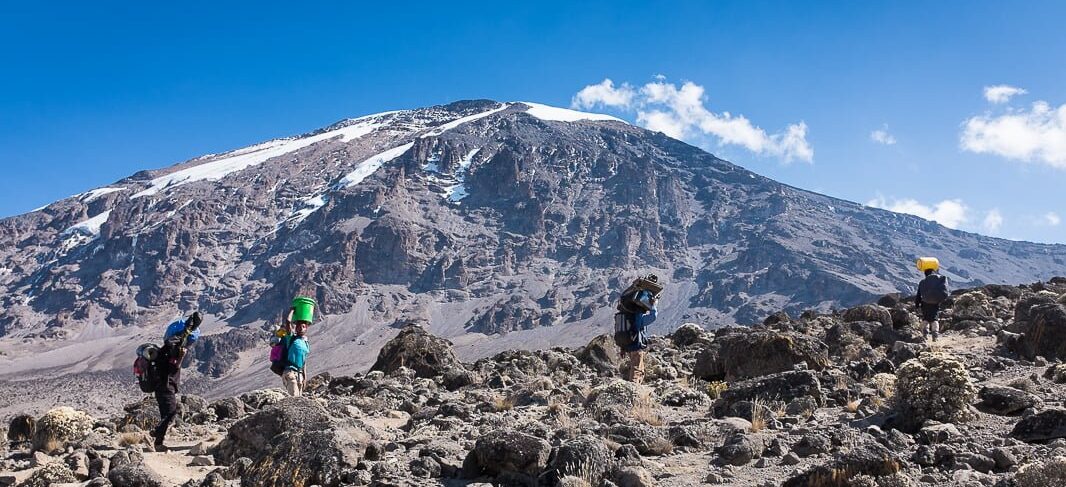The Annual Great Wildebeest Migration
The Annual Great Wildebeest Migration
The annual wildebeest migration is one of the unique wildlife experiences only witnessed in East Africa in two safari destinations i.e., Kenya and Tanzania. it has therefore become one of the most sought for wildlife and nature enthusiasts.
The annual wildebeest migration is the circular movement of millions of animals that cross the Serengeti area – Masai mara in search for fresh water and greener pastures, they also migrate during the calving season where by thousands of calves are born. They move following the rain patterns and the weather conditions. The animals move in columns of wildebeest, followed by thousands of Zebras and gazelles following the route pattern in search for water and pasture. The journey begins from the plains of Serengeti in Tanzania,
Everything you need to know about the Great Wildebeest Migration
If your dream holiday is an African safari, chances are you have already heard about the Great wildebeest Migration, the migration involves the movement of approximately 1.5 million wildebeests and hundreds of thousands of other plains game migrate in circular partner following the rain patterns and also moved by their instinct looking for greener pastures and water. The great Migration is also referred to as the “World cup football for animals’’ this annual mass movement of animals is a one exciting experience and should be top list for Travelers in East Africa. The wildebeest Migration begins from the Savannah plains of Tanzania across along Ngorongoro crater crossing in to Masai mara and vice versa. The migration movement basically depend on the weather patterns thus the timing and the season is not specific and keep changing every year.
for the travelers having interest to witness the wildebeest Migration which is the largest animal movement in the world, here is all the guiding information you will need to know. when? where? and how? about the wildebeest Migration.
When is the best time to see the migration, from Kenya?
The experience occurs every year thus offers an opportunity at any given time for the visitors in the park, since the herds are constantly on the move in a clockwise direction, between Tanzania and Kenya. During the months of January to June, the wildebeest are in the Serengeti, grazing in huge numbers out on the open plains with their calves, slowly making their way north towards the Masai Mara.
Great Migration wildebeest Masai Mara Kenya
The best time to see the migration in Kenya, is between July to September, when the wildebeests are crossing back and forth over the Mara River. The river crossings are considered to be the most sought-after moments as the animals launch themselves into crocodile-infested waters; The mara crossing is dramatic with a lot of emotions, fun but also death at the same time when thousands of animals lose their lives from the dangerous crocodile attacks, predators on the other side looking and waiting closely to attack them for prey.
Time is of the essence here and it’s no good being in a rush. It’s also best to keep in mind that the river crossings can never be predicted and may not happen at all for you, on a particular day. Sometimes, you could be waiting up to several hours before one courageous individual finally plunders down the embankment, triggering a breath-taking stampede in a matter of second
On the other hand, you might be extremely lucky and arrive to find all of the action in full swing – perhaps even witnessing up to several crossings over a couple of hours, as they indecisively thunder back and forth, sometimes right into the open mouths of lions or crocodiles waiting in ambush on the other side.
How best to capture the wildebeest migration experience/ Moments
Capturing the moment during the wildebeest migration can be a thrilling and rewarding experience, as it is one of the most incredible natural spectacles on the planet. Here are some tips to help you make the most out of your photography or videography during this extraordinary event:
Research and Plan Ahead: Before embarking on your trip, do thorough research about the wildebeest migration. Find out the best locations and timings to witness the migration, as the animals move across different areas during different times of the year. Also, consider factors like weather, accessibility, and safety.
Choose the Right Gear: Invest in quality camera equipment suitable for wildlife photography or videography. A DSLR or mirrorless camera with a telephoto lens will allow you to capture detailed shots from a distance without disturbing the animals. Don’t forget extra batteries, memory cards, and a sturdy tripod.
Use Telephoto Lenses: Wildebeests can be skittish, so it’s essential to keep a safe distance from the animals. A telephoto lens with a long focal length (e.g., 300mm or 400mm) will allow you to capture close-up shots without getting too close physically.
Be Patient and Observant: The wildebeest migration can be unpredictable, so be patient and wait for the right moments to unfold. Observe the animals’ behavior and anticipate their movements to capture more exciting shots.
Focus on Emotion and Storytelling: Try to capture not only the vast herds but also the individual stories and emotions of the animals. Photograph moments of struggle, bonding, and triumph to create a compelling narrative.
Mind the Light: The quality of light can make a significant difference in your photos or videos. Golden hours (early morning and late afternoon) often provide the best lighting conditions for capturing warm and dramatic shots.
Use Fast Shutter Speeds: Wildlife is often in motion, and using fast shutter speeds will help freeze the action and avoid blurry images.
Respect Wildlife and Their Habitat: Remember that you are a guest in their environment. Do not disturb or provoke the animals to get a better shot. Maintain a safe distance and follow ethical wildlife photography practices.
Consider Wide-angle Shots: While telephoto lenses are ideal for close-ups, don’t forget to take some wide-angle shots to capture the vastness of the migration and the breathtaking landscapes.
Post-Processing: After your trip, spend time post-processing your photos or videos to enhance their quality. Adjusting exposure, contrast, and colors can make your captures even more stunning.
Above all, immerse yourself in the experience and take the time to enjoy the beauty of nature unfolding before you. The wildebeest migration is a remarkable event, and being present in the moment will undoubtedly reflect in your captures.
Hot air balloon safari over the Great Migration/ Fly over the migration in a hot air balloon
Hot air balloon safari offers one of the unique events during the Migration where you get to explore the vast plains of Masai mara and witness the Great Wildebeest Migration while above the sky and capture the epic moments seen below you. The hot air balloons offer clear sighting of the animals and variety of many other attractions.
Despite it not being a local or cheap experience, it’s without a doubt, once in a life time experience drifting above the vast plains, rivers and the above the forests of Masai mara feels like a big dream come true, the activity is relaxed and less noisy since its just you and your balloon flying above the wild elephants, giraffes and the lions waiting to pounce on the new born wildebeest among other animals for prey.
Where is the best place to stay?
There are many camps and lodges offering a base from which to explore this phenomenal wildlife event; when choosing the packages their other factors that need to be put into consideration. Many accommodation facilities offer full board rates including; (Breakfast, lunch, Dinner) they also offer game drives for an additional fee. Therefore, when considering an accommodation, you need to know all the basic knowledge including; accessibility, it is also nice to choose somewhere with a water source which attracts a variety of wildlife passing through the camp. for instance, Governors’ Camp possibly occupies the best wildlife viewing location in the Reserve.
Find a destination that is obviously family-focused in terms of lodging and dining options, as well as other kid-friendly activities outside game driving, if you are traveling with children. To keep you all together under one (canvas) roof, Governors’ Camp, which is nestled on the banks of the Mara River, provides specially built Family Tent apartments. Younger guests are kept happily occupied while on safari with us thanks to the much-loved Mongoose Club, which also gives them lifelong memories.
Honeymooners and couples might consider Little Governors’ Camp which looks onto a central marsh area and welcomes a high number of repeat guests. Il Moran, located on the picturesque banks of the Mara River, is our luxury offering and only accepts children of eight years and over.
Governors’ camps offer up to three game drives per day (included in your nightly rate) and it is only a 25-minute drive to get to the main crossing points if you head there directly, or 45 minutes if you are happy to meander your way over at a slower pace, taking time to enjoy other wildlife sightings along the way.
What should I pack for this time of year?
Take note; July and August are the coolest months of the year in Kenya and temperatures can sometimes dip beyond 10 degrees. Having said that, this is also our driest time of year, so it’s best to pack wisely. Your morning game drives and early evenings can be on the chilly side. Therefore, you will need some heavy clothes and some light clothes to use during the warmer days.
During the game drive/ Wildlife viewing
Our safari vehicles are open roof/ pop up for optimal gam viewing, although the clear sides can be pulled down should you encounter some unexpected rain, as well as Strong wind on the open plains can certainly take you by surprise and yet during the other days, the sun’s rays are strong and thus requires you to pack well and right.
How can I plan to see the migration?
Even in the best of times, organizing a trip abroad may be a little intimidating and overwhelming. There is never a better time to act than now, and although July through October is our busiest time of year, we still have a few small windows of availability, and we can plan your safari from beginning to end. To make it happen, kindly shoot us an email or get in touch with your favorite tour operator or travel agent.
Flights to Masai Mara Great Migration Kenya




